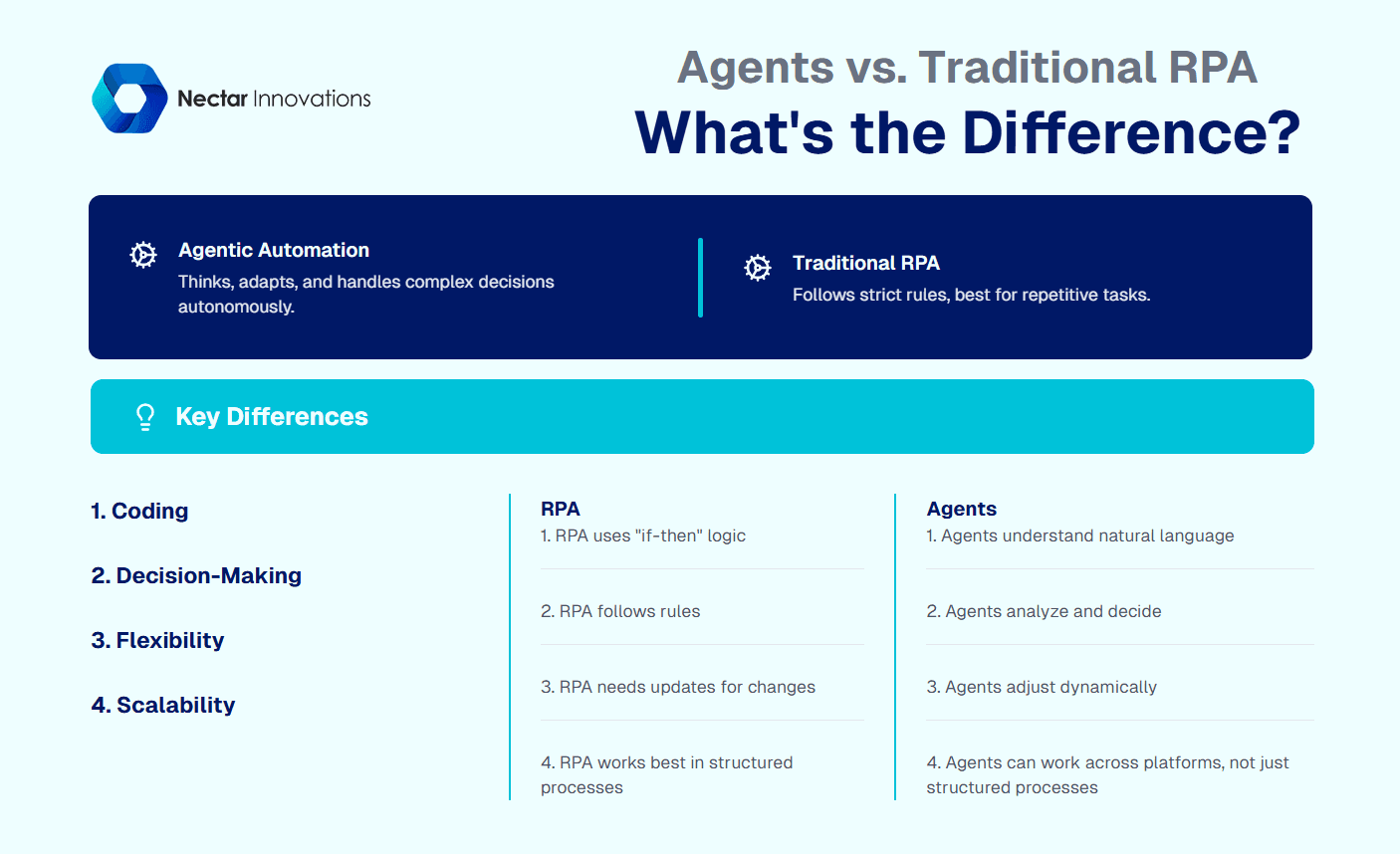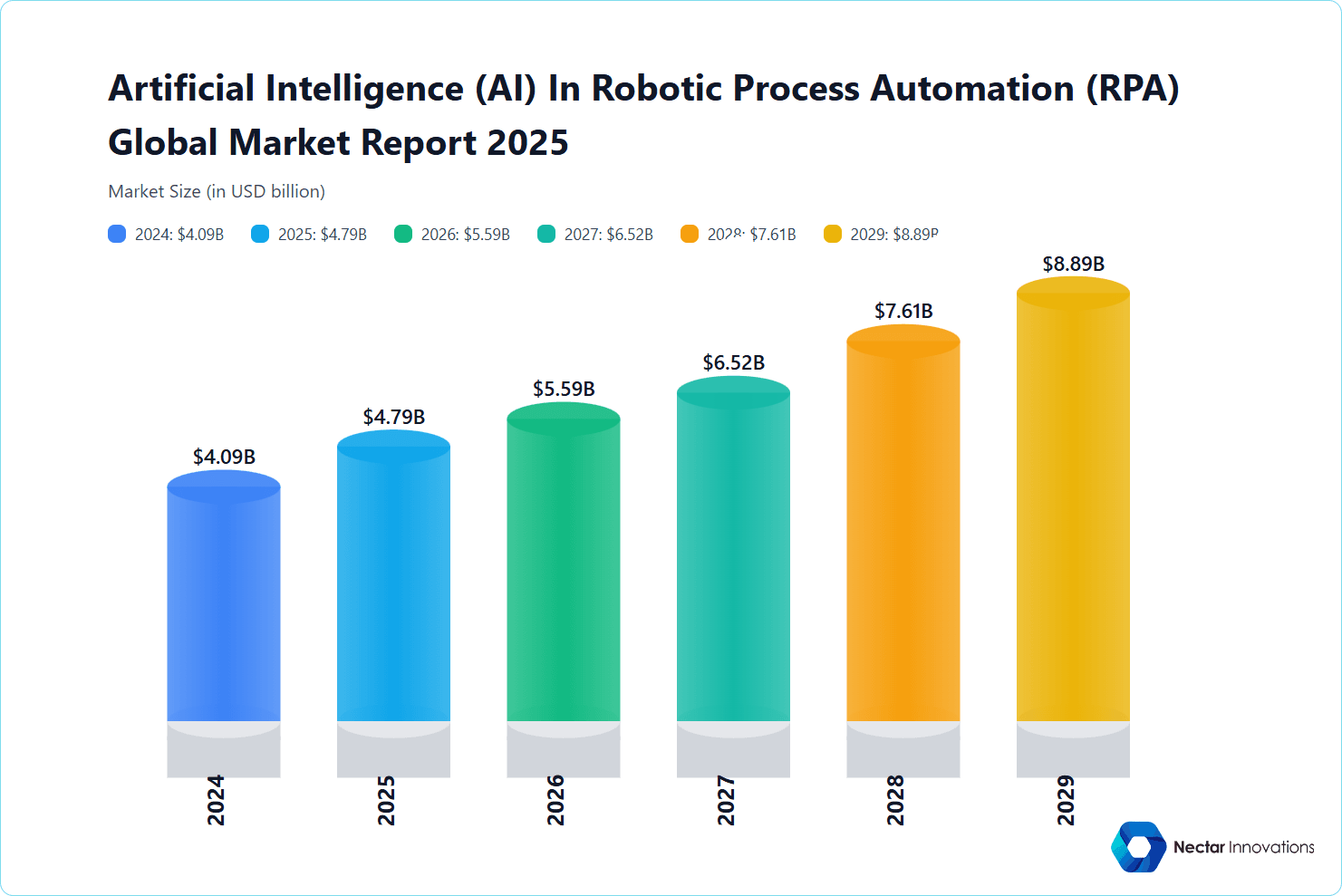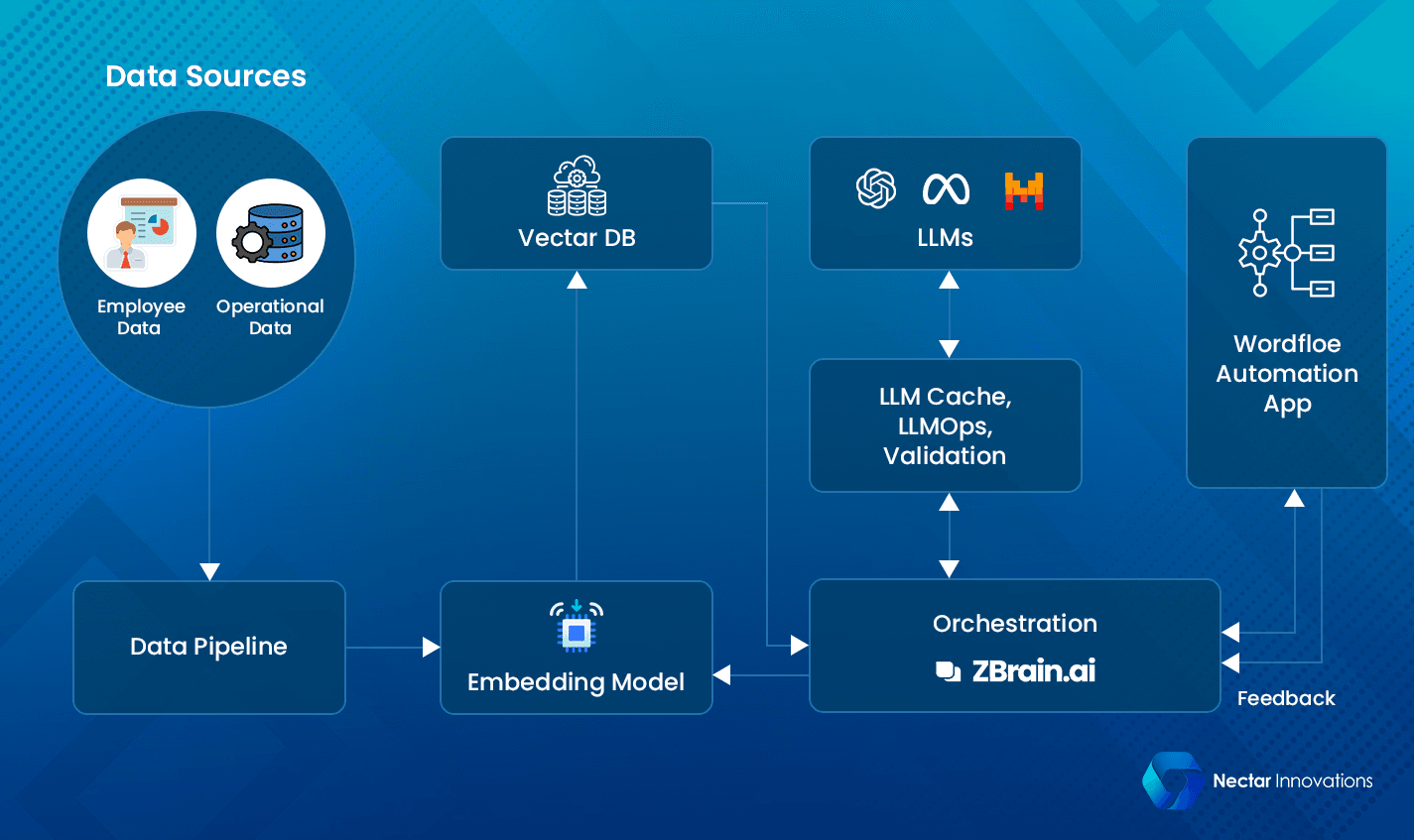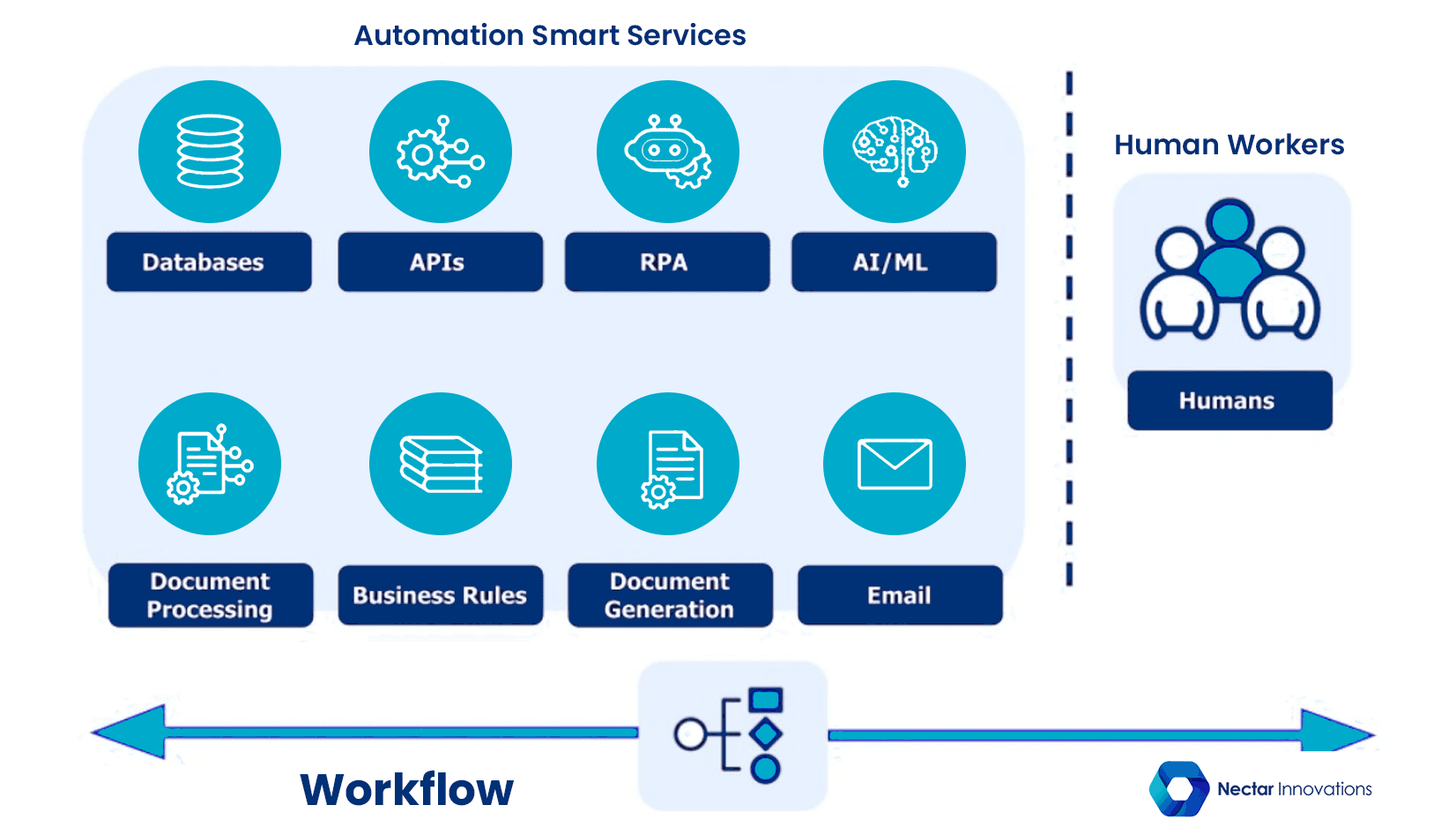The two approaches are fundamentally different. Agentic AI systems can process information and work independently toward defined goals. They excel at adaptive decision-making. Traditional automation systems don't deal very well with large-scale operations and unexpected changes. IBM's results prove this point clearly. Their customer support systems saw a 30% faster response time and 25% higher customer satisfaction after implementing agentic AI.
The future looks promising for agentic AI. Enterprise software applications powered by agentic AI will grow from 1% in 2024 to 33% by 2028. Companies must understand these technological differences to plan their automation strategy effectively. The choice between agentic AI and traditional automation will shape a company's competitive edge. This becomes especially true when handling reasoning tasks, adaptability needs, and decision-making in uncertain environments."
Understanding the Core Differences

The radical alteration from traditional automation to agentic AI means much more than a simple tech upgrade. Agentic AI describes goal-driven systems that notice, reason, act, and adapt on their own to reach specific objectives with minimal human input.
- Agentic AI Definition vs Traditional Automation
Traditional automation runs predefined steps with limited adaptability. It simply follows scripts without deviation. Rule-based, repetitive tasks work well but need explicit programming for every scenario. Agentic AI works through dynamic "observe-think-act" loops and adjusts continuously to changing conditions. This difference becomes crucial because traditional systems fail when workflows change unexpectedly. Agentic systems thrive on adaptation.
- Autonomy vs Rule-Based Execution
Agentic AI's autonomy comes from its self-directed behavior. It plans and learns without constant human guidance. Rule-based systems follow strict workflows and can't adapt unless adjusted. Agentic AI shows what IBM calls it "agency" - it makes decisions based on context and changes strategies dynamically.
Traditional automation stays static after deployment. It offers no learning or improvement as time passes. Agentic AI shows remarkable versatility through reinforcement learning. It finds optimal strategies through trial and error, as with humans learning complex skills.
- Agentic AI vs Generative AI: Key Differences
People often mix up agentic AI with generative AI because their interfaces look alike. But their functions are fundamentally different. Generative AI creates content based on specific prompts without independence. The main difference stands out - generative AI creates, agentic AI accomplishes.
Generative AI excels at producing content (text, images, code) but needs user direction for each step. Agentic AI runs multistep tasks on its own toward bigger goals. Forbes states that "generative AI is largely static... operating within predefined boundaries" while "agentic AI is dynamic... constantly processing new information, learning from its environment, and adjusting actions accordingly".
This difference matters especially when you have complex business processes where adaptability and autonomous decision-making create better operational results.
Cost, ROI, and Operational Impact

Money plays a key role when companies choose between traditional RPA and agentic AI solutions. Both options have different investment patterns that affect business costs now and later.
- Upfront Investment: Traditional RPA vs Agentic AI Platforms
Traditional RPA costs between $10,000-$100,000, which makes it attractive at first. Agentic AI platforms need $50,000-$500,000 or more to start. The higher starting cost comes from technology ($20,000-$200,000), training staff ($5,000-$50,000), and managing organizational changes ($10,000-$100,000).
- Ongoing Maintenance and Technical Debt
The cost picture changes after implementation. Traditional automation needs 40% more human oversight than agentic AI. Studies show that 95% of automation work happens after the first deployment. Agentic AI systems cut maintenance costs by about 30% through self-optimization. This means less technical debt builds up compared to traditional systems.
- Total Cost of Ownership Over 3-5 Years
The real financial story emerges when you calculate TCO. Traditional automation builds up higher costs from upkeep, updates, downtime and missed chances. Agentic AI cuts operational costs by 25%. A detailed 5-year TCO study for mid-sized projects shows $1.10-$5.25 million for agentic solutions, while less adaptable traditional systems could cost more.
- ROI Benchmarks: Time-to-Value and Payback Period
Traditional automation gives quick returns in 3-6 months but has limited growth potential. Agentic AI shows better long-term value with 300% ROI within 3 years, compared to 100% for traditional automation. Companies usually break even with agentic AI in 6-18 months, and 62% expect returns over 100%.
Efficiency, Adaptability, and Workflow Orchestration

The practical differences between agentic AI and traditional automation go way beyond theory. Evidence-based metrics show how adaptive systems perform better in ground applications.
- Task Completion Speed: Static vs Adaptive Systems
Traditional automation works through simple input-to-output models without any follow-up abilities. Agentic AI speeds up execution by removing delays between tasks and making parallel processing possible. This makes a big difference - AI-driven workflow cycles are 20-30% faster than traditional methods. The system's effectiveness shows clearly in insurance claims processing, where handling times have dropped by about 40%.
- Adaptability to Schema Changes and Data Drift
Schema changes pose a major weakness for traditional systems. Traditional automation fails completely when data formats change. But agentic AI keeps watch for schema drift and automatically creates and tests fixes. This self-fixing feature helps systems stay strong against data drift that usually needs human fixes in traditional setups.
- Human Resource Allocation: Programming vs Supervising AI
The changes to workforce are significant. Companies using agentic AI say their employees spend 25-40% less time on low-value work. People's roles have changed from programmers to supervisors - they now guide AI systems instead of doing manual tasks.
- Workflow Orchestration: Manual Triggers vs Goal-Based Execution
Modern workflow orchestration connects automated tasks between systems for smooth execution. Unlike traditional automation's manual triggers, agentic AI uses goal-based execution. It analyzes conditions and adjusts workflows based on what it finds. This self-running approach lets systems adapt to business needs without needing new programming.
Use Cases and Strategic Fit

Agentic AI needs to line up with your business requirements. Real-life examples show that automation approaches differ based on specific situations.
- Agentic AI Use Cases in BFSI, Retail, and Customer Support
AI agents in banking handle loan applications, account updates, credit risk assessment, and claims processing independently. Seasonal businesses benefit from AI that creates flexible repayment schedules matching their irregular income patterns. Retail businesses use agentic systems that predict inventory needs, optimize routes, and reduce supply chain disruptions. Customer service gets better with AI-driven support that runs 24/7, analyzes customer sentiment, and creates individual-specific experiences.
- Traditional Automation Still Makes Sense
Agentic AI isn't always the answer. Simple automation works better with stable, predictable workflows that follow clear rules. Rule-based systems excel in processes that stay constant and need basic execution. Smart businesses save autonomous systems for areas that create real value, such as adaptable customer experiences or quick decisions in changing markets.
- Hybrid Models: Combining RPA and Agentic AI
The best results often come from using both technologies. RPA provides the framework while agentic AI adds adaptability. This "Brain and Hands" model uses AI that handles cognitive tasks while RPA executes specific UI-based operations. These technologies work together to enable complete process automation that manages both structured and unstructured data.
- Checklist: Is Your Business Ready for Agentic AI?
Your business should have:
- Quality data that integrates well across systems
- Well-laid-out automated workflows ready for adaptation
- Business objectives that match organizational goals
- Governance frameworks that monitor AI accountability
- Resources to test pilot programs in low-risk operations
Nectar Innovations can help your team build smarter with AI. Schedule a call today.
Conclusion
Organizations face a key difference between agentic AI and traditional automation when seeking a competitive edge. Traditional automation works best with stable, rule-based processes. It needs a lower original investment of $10,000-$100,000 and delivers faster immediate returns. But agentic AI proves more valuable long-term through its autonomous decision-making and self-healing capabilities. These adaptive workflows cut maintenance costs by about 30%.
Numbers strongly support agentic solutions for complex, evolving business processes. Companies using these systems see their workflow cycles move 20-30% faster than traditional options. They achieve 300% ROI within three years, while traditional automation returns only 100%. This gap grows even wider especially when you have unexpected changes or data drift - situations where regular systems often fail completely.
Smart implementation plays a crucial role in getting the most value. Many companies get the best results by mixing RPA's structured execution with agentic AI's cognitive flexibility. This "Brain and Hands" model enables detailed automation that works with both structured and unstructured data.
Your specific business needs will determine the right choice. Traditional automation fits unchanging, deterministic processes. Agentic AI excels at complex tasks that need adaptation and learning. Companies should check their readiness by assessing data quality, defining workflows, and setting up governance frameworks before deployment. Ready to build smarter with AI? Schedule a call with Nectar Innovations today.
Agentic AI's growth will continue at 25% yearly through 2026. Companies that carefully assess their automation strategy will gain an advantage. Understanding when to use each approach - or combine them effectively - leads to lower operational costs, better customer experiences, and a stronger position in an increasingly automated business world.
Key Takeaways
Understanding the fundamental differences between agentic AI and traditional automation is crucial for making strategic technology investments that drive long-term business success.
- Agentic AI operates autonomously through "observe-think-act" loops, while traditional automation follows rigid, predefined scripts that require manual updates when conditions change.
- Despite higher upfront costs ($50K-$500K vs $10K-$100K), agentic AI delivers 300% ROI within 3 years compared to traditional automation's 100% return.
- Agentic systems reduce maintenance expenses by 30% and accelerate workflow cycles by 20-30% through self-healing capabilities and adaptive decision-making.
- Traditional automation remains optimal for stable, predictable processes, while agentic AI excels in complex, evolving environments requiring autonomous adaptation.
- Hybrid models combining RPA structure with agentic AI flexibility often deliver the best results, creating comprehensive automation across structured and unstructured data.
The strategic choice between these technologies should align with your specific business requirements, data quality, and organizational readiness for AI governance and oversight.





